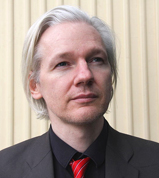WikiLeaks: a brief history

Julian Assange
© 2010 Espen Moe
Assange was an Australian, born in 1971 in the province of Queensland. Raised to a nomadic lifestyle by his mother, Assange was a largely self-taught computer geek. At 22, he was charged on 31 counts of computer hacking and related crimes, and eventually pled guilty and paid a minimal fine. He was an autodidact on such wide-ranging subjects as physics, math, philosophy, and neuroscience. At 18, he fathered a child, and spent years trying to secure a custody agreement (his mother claimed that the stress caused his hair, which had been dark brown, to turn white). [1]
Assange, a believer in the free movement of information, registered the domain name WikiLeaks.org in 1999. But he didn’t start to use it actively until 2006. That year, he feverishly transformed the website into a secure location for whistleblowers, specifically those who wanted to give secret documents a public airing. As he characterizes it, WikiLeaks was “an uncensorable system for untraceable mass document leaking and public analysis.” [2] The first posting, in December 2006, was a decision (never verified) by a Somali rebel leader to execute government officials. In 2007, Assange announced the formal launch of the site.
Assange was the one to start a relationship with the Guardian . As early as 2007, recalls Editor Rusbridger, he received regular emails from WikiLeaks “editor-in-chief” Assange, sometimes with a good story to tell. On August 31, 2007, the two organizations worked in tandem for the first time. WikiLeaks posted the full text of, and the Guardian ran a story on, a report by the private investigations firm Kroll about the alleged corruption of former Kenyan President Daniel Arap Moi. The Kenyan government had chosen to keep the report secret. The Guardian at that point was the only British paper to write about WikiLeaks or use some of its documents.
In 2008 and 2009, WikiLeaks and the Guardian again crossed paths. On two occasions, the UK high court issued an injunction against the paper’s publication of damning documents, first about Barclays Bank tax avoidance strategies, and second on toxic waste dumping in the Ivory Coast by commodity trader Trafigura. WikiLeaks, whose servers were in Sweden and elsewhere, was not bound by any such injunction. It posted numerous of the court-banned materials online.
But there were also instances in which WikiLeaks published documents it thought would prompt a public outcry, and instead the revelations were met with silence. For example, documents from the Guantanamo Bay detention camp, emails from former Republican vice-presidential candidate Sarah Palin posted to Yahoo!, and secret Scientology manuals sparked little reaction. By spring 2010, Assange had concluded that to get word out, it made sense to align with the mainstream press. So in April, he released at the National Press Club in Washington, DC, a 2007 video of two US Apache helicopter pilots allegedly executing people on the ground in Iraq, including two Reuters correspondents. The helicopter video got attention, but much of it focused on Assange’s clumsy packaging and editing of the material, which he dubbed “Collateral Murder.”
Then in late May, Assange vanished. The reason soon emerged. The story did not attract much media attention, but the Pentagon on May 26 had arrested US Army Private Bradley Manning, 22, on charges of illegally downloading hundreds of thousands of classified US documents, including—reports said at the time—a trove of State Department cables on Iraq and Afghanistan. Apparently, Manning may have given the documents to WikiLeaks. [3] One of those who read a small news item on Manning’s arrest, and that the State Department was looking for Assange to question him, was veteran Guardian investigative reporter Nick Davies . Davies resolved to find Assange.
[1] Raffi Khatchadourian, “No secrets,” New Yorker , June 7, 2010.
[2] Ibid.
[3] Philip Shenon, “Pentagon Manhunt,” Daily Beast , June 10, 2010.